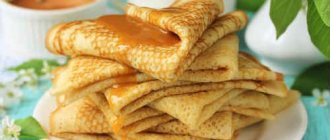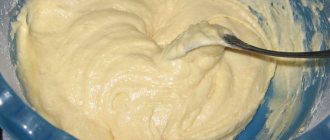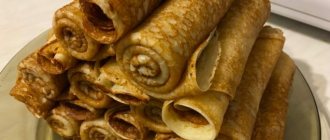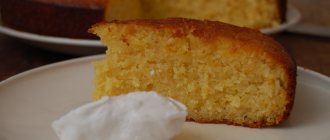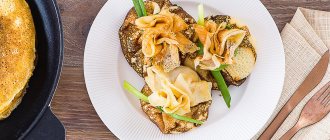There are many recipes for making pancakes. It doesn’t matter which one you prefer, any of them will have flour among the main ingredients. Don’t be lazy to sift it: this way you will not only clear it of lumps and impurities, but also saturate it with air. With this flour the dough becomes light and fluffy.
For the best pancake mix, it is advisable for the milk and eggs to be at room temperature. They should be taken out of the refrigerator in advance or warmed a little before use. Ideally, it is better to beat the yolks and whites separately. Proteins, brought to a fluffy foam, must be added at the very end to make the dough lacy. Flour is introduced gradually and carefully, constantly stirring the dough. But this should be done after you have thoroughly mixed the liquid ingredients.
Don't forget to add at least a pinch of salt to the dough, even if you are planning dessert pancakes. Salt gives the dish an interesting and rich taste. Another important touch is a little sunflower oil: with it the dough will stick to the pan less, and you will have to grease it less often. A sign of a good freshly kneaded dough is small bubbles on its surface. Over time they disappear.
What consistency should the dough be?
The golden mean is important here: the dough should not be too thick or too thin. Its ideal consistency is a bit like liquid sour cream or heavy cream. The dough should not spread in the pan too quickly or too slowly. In the first case, you need to add a little more flour to it, and in the second, dilute it with warm water: it improves not only the consistency of the dough, but also has a positive effect on the taste and fluffiness of the pancakes.
When pancakes stick to the pan and tear, the reason is in the oil
To be more precise, in this situation the cause is not just oil, but its lack. The mother-in-law explained that this ingredient must definitely be added to the dough, but only in moderation, strictly following the recipe.
In addition, during the process of frying pancakes, the pan must be greased each time before pouring a new portion of dough into it. To do this, it is most convenient to use a special brush or an ordinary napkin.
By the way, pancakes can stick to the pan not only due to a lack of oil component. Often the cause of this phenomenon is insufficient heating of the surface of the cookware (by the way, this is why the first pancake always turns out lumpy). Common reasons also include:
- excess spices in the dough;
- dough consistency is too liquid;
- unsuitable frying pan material (the ideal option is cast iron with a non-stick coating).
If the frying pan has a Teflon coating, then this may be the problem with tearing pancakes. To avoid troubles during the cooking process, you should add a little boiling water to the pan - when it evaporates, the problem will solve itself.
How and with what to grease a frying pan?
Suitable lubricants for frying pancakes are: vegetable, butter or ghee, lard or any animal fat. To ensure that the surface of the pan is evenly greased, you can use half an onion or a raw potato placed on a fork. Our grandmothers also used this “brush”. You can replace it with a regular silicone culinary brush. You need to grease not only the bottom of the pan with oil, but also its entire inner surface.
Pancakes are torn - what to do?
So, now you already know why pancakes tear. Any of the above reasons can be easily corrected by adding the missing ingredients to the dough. To ensure perfect baking, follow the advice of experienced chefs.
- Always strictly adhere to the recipe. To measure the exact amount of an ingredient, use a kitchen scale.
- You can knead the pancake dough by hand or using a mixer. The main thing is that it becomes homogeneous and all the lumps disappear. A small amount of liquid is added to the dry ingredients, mixed thoroughly, and only after that the rest of the milk or kefir is poured in.
- Before pouring a portion of the workpiece into a frying pan, heat it well on the stove and grease it with a small amount of animal fat.
- While baking pancakes, the heat can be reduced slightly.
To prevent the pancakes from tearing, turn them over with a special spatula. First, lift the edges of the tortilla, and then flip it over in one swift motion. A massive cast iron frying pan is ideal for preparing such baked goods. If you don't have such cookware, use a non-stick fryer or a special pancake maker.
Housewives have an ambiguous attitude towards pancakes, or rather, towards baking them. Some people think that baking pancakes is as easy as shelling pears. Others don't even take on this troublesome task.
And all because pancakes are an unpredictable dish, and sometimes they tend to tear. Moreover, not only the first pancake turns out “lumpy”, but also the subsequent ones.
In fact, even a novice housewife can learn how to bake pancakes. The main thing is that you only need to remember a few simple rules for preparing this dish, and also become familiar with the reasons why pancakes fail. For example, they tear when turned over.
How much and how to pour the dough?
The thickness and taste of the pancakes depends on the amount of dough in the pan. The capacity of the ladle needs to be measured against the size of the frying pan and the ideal ratio must be found. For example, for a medium-sized frying pan (with a bottom diameter of 20 centimeters), one standard ladle (about 0.14 milliliters) of dough will be quite enough. There are two best known ways of pouring dough: into the middle of the dish and from one of the raised sides. In any case, it is necessary to achieve uniform distribution of the dough over the bottom of the pan. To do this, you need to quickly and carefully pour the dough, slightly tilting and rotating the bowl clockwise.
How to heat a frying pan correctly?
The main reason for lumps in pancakes is an insufficiently heated frying pan. Please note that a cast iron frying pan takes longer to heat up than a regular Teflon frying pan. The size of the burner is selected according to the size of the frying pan. The smaller the burner, the stronger the flame should be, but do not bring it to maximum. The best option is a medium burner with medium heat intensity. On a wide burner there is a risk that the core of the pancake will not cook well. You can speed up the cooking process by using 2 or 3 pans at once.
Delicious recipes and useful tips on how to properly fry pancakes in a frying pan
Greetings, my dear blog readers! Today we’ll talk about such delicious things as pancakes. I think everyone loves them. But not everyone knows how to cook them correctly. I want to share the secrets of how to fry pancakes in a frying pan. As well as various delicious recipes.
Before we move on to cooking, let’s decide what to fry on. If you have a good cast iron frying pan, it is better to cook on it. If not, no problem. Suitable with ceramic coating or any non-stick coating. Make sure that the pan is not very thin. This pan will heat up and cool down very quickly. The pancakes will not bake, but will burn and burn.
When and how to flip pancakes?
When frying pancakes, it is important not to dry them out. The condition that signals the pancake needs to be flipped is a smooth, bubbly, slightly golden surface with no remaining batter. There is no need to wait until the bottom of the cake turns chocolate brown. Although some people really like these crispy pancakes.
Before flipping the pancake, run a spatula along the edges, gently peeling them away from the surface of the pan. Then, sliding the spatula to the middle of the pancake, quickly turn it over. It is best to use a thin wooden spatula for these purposes. Metal utensils can damage the coating of the pan and tear the thin pancake circle.
Pancakes with kefir: how to avoid sticking
Many housewives prefer pancake recipes with kefir. They always turn out very tender and thin, but this is the problem. After all, it is very difficult to turn such a pancake over.
Experienced housewives advise following several rules to ensure that your kefir pancakes always turn out perfect. Select a thin spatula for turning, wash thoroughly and then wipe dry the frying pan, and also add vegetable oil to the dough.
To ensure your pancakes always flip easily, we've put together some general tips:
- grease the pan along with the sides;
- for baking pancakes, choose frying pans with a thin bottom and edges;
- select the required temperature mode (high and low heat equally contribute to the adhesion of the dough);
- When making the dough, use only room temperature products.
And finally, I would like to say that there are no housewives who do not know how to bake pancakes. If they don’t work for you, then it means you just haven’t found your recipe yet. Try it. And one day a stack of fragrant and delicate pancakes will definitely appear on your table.
The first damn thing is lumpy. This saying very often turns out to be true. But what to do if the dough doesn’t want to come off the pan the second or third time? The first step is to find the cause of the problem. There may be several of them:
- There are not enough eggs in the dough. When mixing pancake dough, strictly follow the recipe. The eggs bind all the ingredients together and prevent the baked goods from tearing and sticking to the pan. The lack of this ingredient disrupts the density and structure of the dough. To save the workpiece, add 1-2 eggs and a few tablespoons of flour. Mix everything thoroughly so that there are no lumps and start baking.
- Lack of flour. During frying, almost all the moisture evaporates from the dough. If the dough is too liquid, the cake turns out to be very thin and it is almost impossible to turn it over without damaging it. You can easily correct the mistake by adding a little more flour and thoroughly stirring the dough until smooth.
- Little fat in the dough. Because of this, pancakes may not release well from the pan. If you notice a problem, simply add a few teaspoons of vegetable oil to the dough.
When preparing pancakes, try to put as little spices and sugar into the dough as possible. To make baked goods sweeter and more flavorful, use fruit jams or caramel sauces.
How to transfer pancakes from a frying pan to a plate?
There are at least 3 ways to do this: using a wooden spatula, a fork and a masterly release with an accurate calculation of the trajectory of its flight onto the plate. The first option is the most convenient and simple: from an inclined frying pan, a pancake, held with a spatula, slowly slides onto a plate. The second method is more risky: using a fork can damage the pancake, but with its help you can easily find out about the degree of readiness of the dish. The third, effective option is difficult to implement without proper training and skills.
How to serve pancakes?
It is worth considering in advance the number of people you are going to treat with pancakes. On average, there are 3-4 pancakes per serving. But during Maslenitsa, 5 pancakes per guest “fly away”. On this holiday, pancakes can be served as a main course, and not just as a pastry for tea. A plate with a stack of pancakes, several bowls with sauces are placed in the center of the table, and guests are given personal plates with forks and teaspoons. And don't forget about napkins - there should be enough for everyone.
Two video recipes for pancake dough from the chef of our website
Povarenok has many proven pancake recipes, which you can find in the video or on our website.
Subscription to the portal “Your Cook”
To receive new materials (posts, articles, free information products), enter your name and email
In the article you will learn the main reasons why pancakes tear and stick when turned over and what to do in this situation + a recipe for thin pancakes that never stick to the pan. It would seem that nothing could be easier than making pancakes, because this is not such a complicated dish. It seems that there can be no serious difficulties in preparing them. But some housewives never cease to wonder why pancakes tear and stick when turned over, what to do when such a misfortune happens every time?

